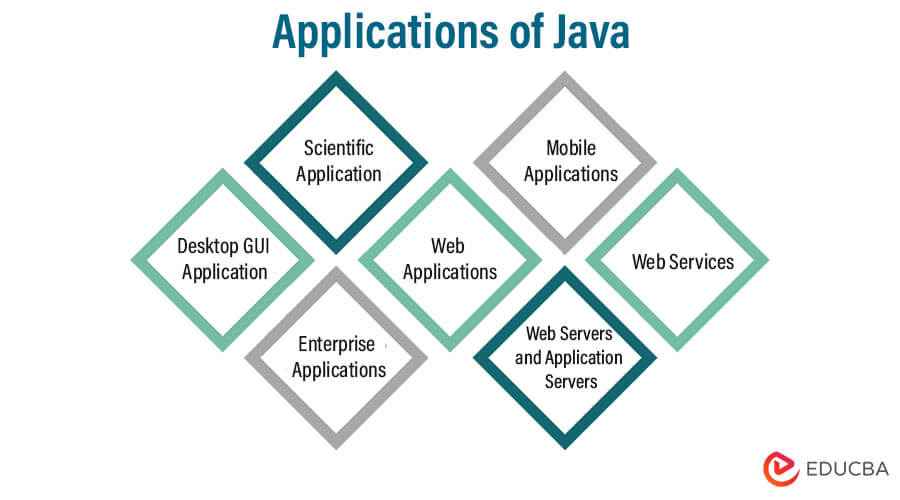Introduction to Applications of Java
Java is one of the most popular programming languages in the world, with billions of devices running on a Java platform. It is an object-oriented language that supports all the features of object-oriented programming. Java is also one of the most secure programming languages in the world and has plenty of applications.
Many banking applications are developed using Java, which is easy to learn, similar to C and C++. Additionally, Java supports multithreading, making it useful for game development. Java also enables the development of distributed applications. There are many Java frameworks available, such as Spring, Hibernate, JSP, Servlet, and SpringBoot, that make Java even more powerful. Enterprise application development often prefers Java because of its security and scalability features.
Applications of Java in the real world
Below are the top 7 applications:
1. Desktop GUI Application
Java is a powerful language for developing desktop applications, with AWT, Swing, and JavaFX support. AWT (Abstract Window Toolkit) is used to develop desktop application UIs, and it inherits Windows UI functionality, thus not completely Java-based. On the other hand, Swing is entirely based on Java and allows for the developing of pure Java-based desktop applications.
JavaFX is a modern approach to developing desktop applications in Java, with a graphical user interface that differs significantly from AWT and Swing. With these packages and frameworks, developers can create any desktop application. NetBeans IDE also offers drag-and-drop features, making it easier to develop UIs in less time. When dealing with JavaFX, developers can utilize ScenBuilder software to build the application’s UI.
2. Scientific Application
Developers widely use Java for developing scientific applications due to its robustness and security features. Many scientific applications are based on Java technology, for example, MATLAB, which is based on Java for both its front-end and back-end. Java provides Struts, JSP, and Servlets for the front end, while core Java can be used in Servlets for the back end. Applications related to research, science, and medicine utilize Java due to its powerful mathematical calculations, which produce consistent results across different platforms.
3. Enterprise Applications
Java is the top choice for enterprise application development due to its powerful features that meet the requirements of modern businesses. Most enterprise sites today are based on Java applications because Java is secure, powerful, and scalable. These sites require high levels of security, which Java provides. It also has strong memory management features that automatically delete unused memory, improving the performance of large applications. Trading sites, in particular, require high performance to increase their audience and utilize Java.
Java runs inside the JVM (Java Runtime Environment), which verifies that bytecode comes from the external system to prevent security holes. Java applications are also easily scalable in the event of increased traffic to the enterprise site. It is the most secure language, which is why most banking applications are developed on the Java platform. Java provides a multithreaded environment that allows multiple threads to run together, improving the system’s performance. This is one of the reasons why Java is selected over other programming languages.
4. Web Applications
Java is widely used for developing web applications, and it provides various technologies to support web development, such as JSP, Servlet, Struts, Spring, and Hibernate. With the help of these technologies, developers can easily develop any web application based on customer requirements. Servlets and JSPs are server-side components that help develop the business logic of web applications. JSPs are an extension of servlets and have more features than servlets, making them easier to use due to tags similar to HTML. These are the main components of Java that help develop web-based applications, and developers can develop any web-based application with these technologies.
5. Mobile Applications
Java is widely used for developing mobile applications, particularly for the Android operating system based on Java. With Java, developers can easily create various kinds of Android apps easily. Android Studio is the primary tool for coding Android applications, and any Android phone can serve as a simulator to test the application. Android follows Java conventions, making it easy for Java developers to learn Android and begin developing required applications.
6. Web Servers and Application Servers
The Java ecosystem includes several web servers and application servers today. Some popular web servers are Apache Tomcat, Simple, Jo!, Rimfaxe Web Server (RWS), and Project Jigsaw. On the other hand, WebLogic, WebSphere, and JBoss EAP dominate the commercial application server space.
7. Web Services
Java is a popular platform for developing web services and is independent of platform and language. Applications developed in other languages can easily consume Java web services. Java provides support for SOAP and REST-based web services, each with advantages and disadvantages. SOAP is more secure than REST, but it supports only the XML data format and requires adherence to numerous conventions during development. On the other hand, REST supports multiple data formats such as JSON, HTML, and XML, which makes it more widely used than SOAP. Additionally, REST requires less bandwidth during the development of web services.
Conclusion
Java is a popular programming language with uses in various fields of software development. It is especially preferred in the development of secure and scalable applications, such as banking applications, where security is a major concern. This has resulted in high demand for Java developers in the job market.
Recommended Articles
We hope that this EDUCBA information on “Applications of Java” was beneficial to you. You can view EDUCBA’s recommended articles for more information.




